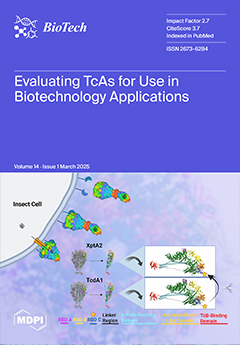Organisms from the genus
Streptomyces feature actinobacteria with complex developmental cycles and a great ability to produce a variety of natural products. These soil bacteria produce more than 2/3 of antibiotics used in medicine, and a large variety of bioactive compounds for industrial,
[...] Read more.
Organisms from the genus
Streptomyces feature actinobacteria with complex developmental cycles and a great ability to produce a variety of natural products. These soil bacteria produce more than 2/3 of antibiotics used in medicine, and a large variety of bioactive compounds for industrial, medical and agricultural use. Although
Streptomyces spp. have been studied for decades, the engineering of these bacteria remains challenging, and the available genetic tools are rather limited. Furthermore, most biosynthetic gene clusters in these bacteria are silent and require strategies to activate them and exploit their production potential. In order to explore, understand and manipulate the capabilities of
Streptomyces spp. as a key bacterial for biotechnology, synthetic biology strategies emerged as a valuable component of
Streptomyces research. Recent advancements in strategies for genetic manipulation of
Streptomyces involving proposals of a large variety of synthetic components for the genetic toolbox, as well as new approaches for genome mining, assembly of genetic constructs and their delivery into the cell, allowed facilitation of the turnaround time of strain engineering and efficient production of new natural products at an industrial scale, but still have strain- and design-dependent limitations. A new perspective offered recently by technical advances in DNA sequencing, analysis and editing proposed strategies to overcome strain- and construct-specific difficulties in the engineering of
Streptomyces. In this review, challenges and recent developments of approaches for
Streptomyces engineering are discussed, an overview of novel synthetic biology strategies is provided and examples of successful application of new technologies in molecular genetic engineering of
Streptomyces are highlighted.
Full article






